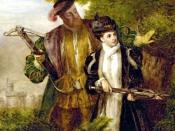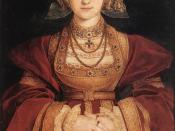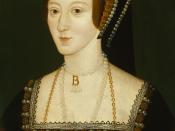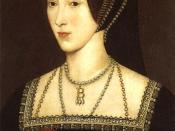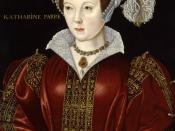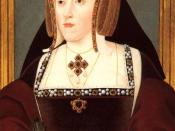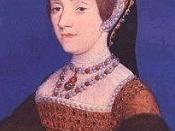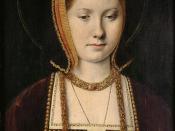Anne Boleyn was the second wife to King Henry VIII. However, that was about the only "second" that is attached to her name: Anne was the first woman to replace a rightful queen, the first queen to have a public trial, and also the first queen to be publicly executed in England. During her reign, both the common people and nobles alike were in turmoil. Never before had a simple adulteress, even one from a noble family, caused such a political uproar in England.
Anne Boleyn was born sometime between 1502 and 1509 in England. When she was a young toddler, Anne was sent to be brought up in the French court. There she was taught to read, write, and be a proper noble lady. She also became fluent in English, Greek, Latin, and French. Around age 15, Anne was brought home to England. Because Anne was born to a noble family on the rise, she was given a position as one of Queen Catherine's ladies in waiting.
Anne wasn't the typical Tudor beauty. Beautiful girls of the time were fair skinned and light haired. Lady Anne, however, had raven black hair and an olive tone to her skin. She was also famed for her jet black eyes, which could either be sultry and appealing or cold as ice. Though Anne wasn't the typical beauty and was rumored to have many moles and a sixth finger, one would wonder how such an "ugly girl" could be so captivating and attractive to the King of England.
Somewhere around the summer of 1526, King Henry VIII took a special liking to his wife's lady in waiting. He showered her with gifts; everything from a new hunter (horse) to riding gloves, jewels, and gowns. Anne showed her gratitude and love for the King in a love letter written to him that summer. Anne was unlike the king's numerous previous mistresses. For one, she was not a "true" mistress until approximately 6 years into her courtship: she did not bed with Henry until about six months before their wedding. Accounts of the courtship between the King and the younger Boleyn girl suggest that, instead of holding the King with sex as his other "whores" did, Anne captivated him with charm and wit (and, as rumors have it, with "French whore's tricks").
Anne's supposed chastity did little to save her reputation at court. Nearer the time of his annulment to Queen Catherine of Aragon, King Henry wrote to her asking her to relinquish several jewels of the crown to Anne. After receiving this letter, Catherine replied to her soon-to-be ex-husband, "I will not give them up to a person who is the scandal of Christendom and a disgrace to you". Catherine was sure that her husband wouldn't ever set her aside all on a whim for Anne. Though she fought with Spain and the Pope at her back, King Henry did indeed annul his marriage to Catherine of Aragon. This sent the country of England into a slight turmoil. Queen Catherine had done nothing wrong (except, of course, fail to produce an heir to succeed Henry on the throne), why should the King be allowed to set aside a good, faithful wife? No king had done such a thing before. The common people showed their displeasure openly at Anne's coronation in 1533. Though the nobles were dressed to impress, the crowd did not support Anne's rise to power. They chanted many ill-wishes, along with witty quips like "HA! HA!" (a mocking of Henry's and Anne's initials) as she rode the royal barge after leaving the Tower of London.
Not long after her coronation, Queen Anne was with child. Soothsayers were brought in, all positive that Anne was to have a boy. The public softened their disdain for the queen at hearing this: a male heir was needed to take the thrown of England. However, on September 7th, there was neither little "Henry" nor "Edward". Anne instead gave birth to her first and only child, Princess Elizabeth. She became pregnant several more times but never managed to carry her babies to full term. After giving birth to a particularly grotesque, malformed stillborn, the king began to get suspicious of witchcraft and adultery. He seemed to think that God was punishing Anne for something horrible, and that was why she was unable to bear him sons. Henry was in the same predicament as he was with Catherine: he still had no male heir to succeed him on the thrown.
In 1536, Queen Anne, along with several of the men in her court (among them her brother George, Lord Rochford), were arrested and sent to the Tower. She was then taken to the Tower by barge, ironically, along the same path she had traveled to prepare for her coronation just three years earlier. On Monday the 15th, the Queen and her brother were put on trial at the Great Hall of the Tower of London. Approximately 2,000 people attended her trial, for it was a first. No English queen had ever been put on trial before. Anne conducted herself in a composed and noble manner, denying all the charges against her. However, Anne's poise and maturity did little to help her: Even though the evidence against them was scant, both Anne and her brother (along with the four men of her court) were found guilty. They were to be either burnt at the stake (which was the punishment for incest) or beheaded.
On the morning of May 19, 1563, Anne was lead to the scaffold. Again, it was a first: no queen had been publicly beheaded in England prior to Anne Boleyn. The Queen was surprisingly calm as she delivered her speech: 'Good Christian people, I am come hither to die, for according to the law, and by the law I am judged to die, and therefore I will speak nothing against it. I am come hither to accuse no man, nor to speak anything of that, whereof I am accused and condemned to die, but I pray God save the king and send him long to reign over you, for a gentler nor a more merciful prince was there never: and to me he was ever a good, a gentle and sovereign lord. And if any person will meddle of my cause, I require them to judge the best. And thus I take my leave of the world and of you all, and I heartily desire you all to pray for me. O Lord have mercy on me, to God I commend my soul.' After being blindfolded and kneeling at the block, she repeated several times: 'To Jesus Christ I commend my soul; Lord Jesus receive my soul.' The swordsman then brought his axe down upon Anne's neck, which was said to be so slender and elegant, and ended her life. Though the people of England never cared much for Anne, they were in outrage at her death. It was the second time that Henry had put aside a good wife for no real reason except for want of a new one. However, the common people could do nothing to change this simple fact, and the nobles could only push the lady they favored into the King's path in hopes he might make her the new Queen of England.
Queen Anne's legacy lived on even after her untimely death. Her daughter, Elizabeth, later became the greatest Queen England has ever had. Even today, most people know the story of King Henry and his six wives, Anne of course being the most famous. Several songs have been written about the unfortunate queen's fate, including a comical and mocking tune written in the 1930s by Rudy Vallee, the chorus of which goes "With her 'ead tucked underneath her arm, She walks the bloody Tower, With her head tucked underneath her arm, At the midnight hour." Even over 400 years later, the late Queen Anne is still remembered around the world.
BIBLIOGRAPHYDenny, Joanna. Anne Boleyn: A New Life of England's Tragic Queen (2004)Starkey, David. Six Wives: The Queens of Henry VIII. New York: HarperCollins (2003)Warnicke, R. M. The Rise and Fall of Anne Boleyn: Family politics at the court of Henry VIII (1989)Weir, Alison. The Six Wives of Henry VIII (1991)
